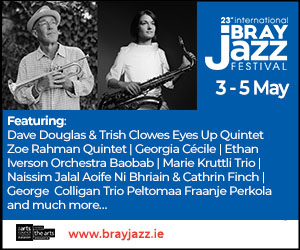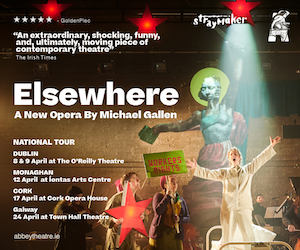
Composer Annea Lockwood in 'History of the Present'
Sounds and Silences of the Troubles
Who has the right to speak? And in what way? These are the questions at the centre of a new experimental opera-film, History of the Present, which received its world premiere at the Belfast International Arts Festival on 19 April. The opera-film, co-directed by Belfast-born writer Maria Fusco and Glasgow-based film artist Margaret Salmon, with new music by composer Annea Lockwood, is a provocative challenge to official history-making, timed to coincide with the twenty-fifth anniversary of the Good Friday Agreement.
The premiere took place in the Queen’s Film Theatre. On the same day, only a few hundred metres away, British Prime Minister Rishi Sunak, former US President Bill Clinton, former US Secretary of State Hillary Clinton and Irish Taoiseach Leo Varadkar were meeting to mark a quarter-century of hard-earned, uneasy peace. While politicians met to reinforce official narratives of post-conflict Northern Ireland, nearby in the Queen’s those narratives were being deconstructed.
Made of fragments
History of the Present is a piece made of fragments, with a libretto by Fusco at its heart. Now a Professor of Interdisciplinary Writing at the University of Dundee, Fusco was raised in the working-class Ardoyne district of North Belfast, and her childhood was marked by the violence of the Troubles. With her opera-film, Fusco and her collaborators intend to amplify working class women’s voices, in the context of their traumatic histories in the North. The result is a poetic blend of voice, sound, image and movement – a piece that frustrates genre and category, revealing a line of unanswered questions.
The opera-film opens with a black frame and silence. Gradually, resonant metallic sounds rise up from the darkness. This is the score by pioneering electro-acoustic composer Annea Lockwood. To create the soundscape of the piece, Lockwood and her team used various methods of field recording on location at the Ardoyne ‘peacelines’ – the walls of demarcation separating Loyalist and Nationalist communities in Belfast. The composer employed innovative recording techniques to ‘play’ the peacelines: stroking the metal walls with a fragile leaf; gently striking them with stones; sliding the heavy locks on gates to create resonant, droning sounds. These sonorities convey the weight and materiality of the dividing infrastructure, and they provide a dynamic bed for the other layers of the piece. In a memorable sequence in the opera-film, we see Lockwood – studio headphones on – coaxing sounds from her found instrument.
After a sonic preamble, we are thrust into light. Singer and improviser Héloïse Werner is stark against a white background. ‘A bit louder,’ she says, to someone off camera. ‘A bit louder still.’ For a long moment, she closes her eyes and listens. And then, eyes half-opening, as if in a trance, Werner expels a series of extraordinary sounds. The viewer isn’t made aware until the closing credits, but Werner is improvising to sounds carried through an earpiece. Sounds of violence, deeply familiar to those who lived through the Troubles: helicopters, Saracen tanks, police sirens, gunfire. The uncanny technique, repeated throughout the work, is riveting. Werner’s voice is exposed and alone. Her powerful, committed performance is deeply effective.
Why is this an opera?
Fusco initially developed History of the Present through a Royal Opera House Engender Fellowship, an initiative aimed at achieving gender equity in opera and music theatre. At the outset of the project, she was asked, ‘why is this an opera?’ Her answer, in the form of the opera-film, is that the human voice has the capacity to hold and to handle history: ‘history enters the body through sound, and exits the body through the voice.’
Salmon’s intimate, illuminating camera work captures the moments when these traumatic histories are sounded, sometimes violently, by Werner. We see the raw physicality required by the improvisatory techniques.
The opera-film was shot on 35mm, and like Lockwood’s recording techniques, this cinematic choice gives weight to the visual dimension of the piece. Fusco and Salmon made the conscious decision not to use archival film footage of the Troubles, and instead to document scenes from contemporary Belfast: the port, the streets of Ardoyne, the peacelines, ordinary people going about their ordinary lives. Small connections. Subtle divisions.
Behind Salmon’s images of the present, Fusco’s libretto, Lockwood’s score and Werner’s performance haunt the piece with sonic memories of violence.
Throughout History of the Present, voices from the past are introduced through archival audio recordings from Fusco’s collection. We hear conversations of working-class Belfast women talking around a kitchen table, ignoring briefly the conflict outside.
Perhaps the most emotional moment of the piece comes with an old audio recording of Fusco as an infant, imitating the tones and inflections of her mother’s voice. The child utters mostly nonsense. An inarticulate music. But close listening reveals a voice learning, slowly but surely, to speak for herself.
History of the Present will tour internationally and can seen at Art Night Dundee, Scotland (24 June); Royal Opera House, London (2 July); the Edinburgh Art Festival, Scotland (11 August).
Published on 27 April 2023
Jonathan C. Creasy is a writer, musician and filmmaker based in Dublin, where he teaches on the Creative Writing faculty in UCD.


















